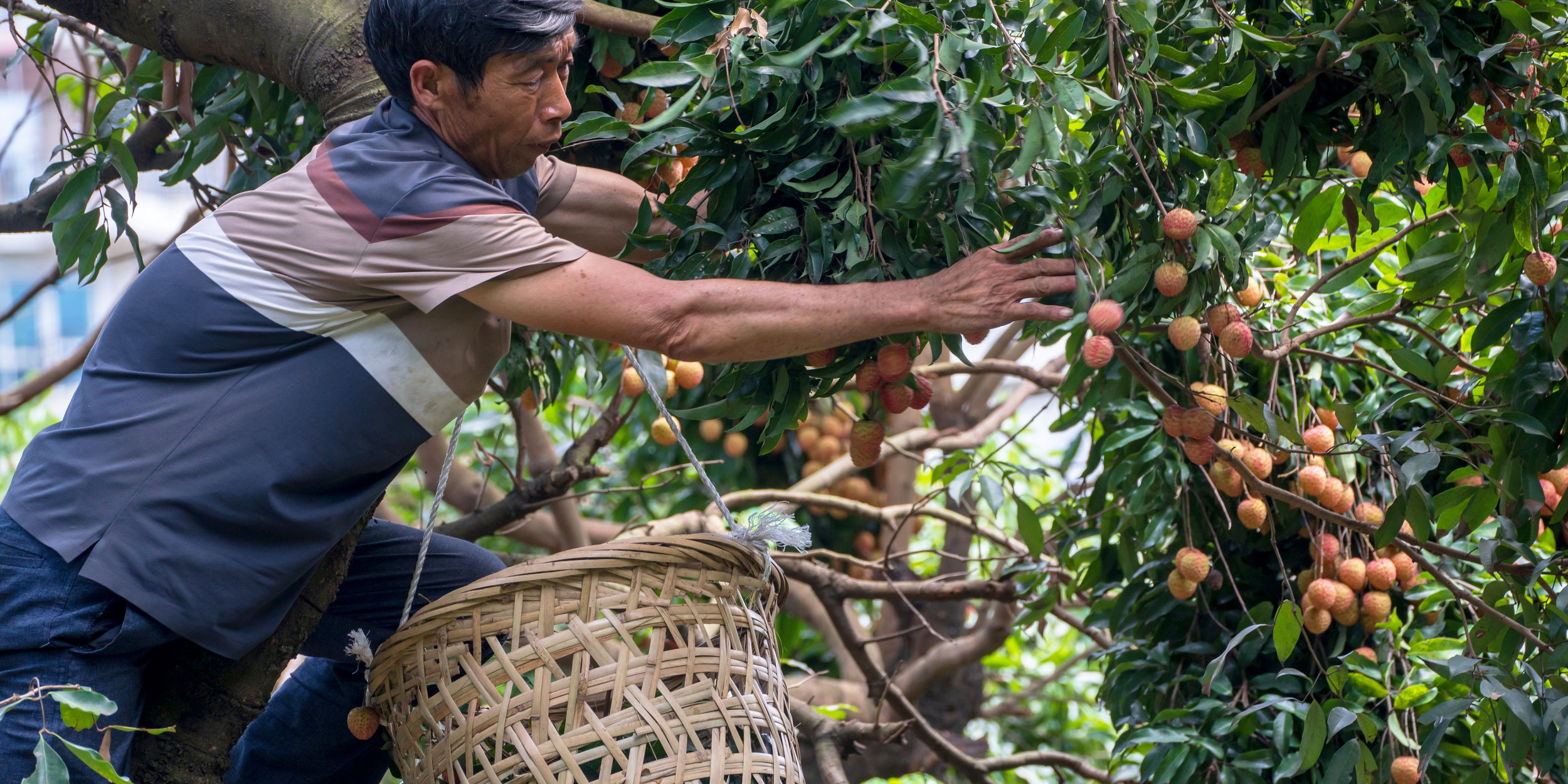
In China, a Good Year for Lychees Becomes a Bad One for Farmers
It’s dawn, and Qin Shaofen is strolling among the 500 lychee trees at her family’s orchard on the outskirts of Guangzhou, capital of China’s southern Guangdong province. This year, the branches are laden with fruit, with 2,500 kilograms set to ripen in just a few weeks.
Qin and her family should be looking forward to the rewards of their harvest. Instead, they face a race against time to avoid financial catastrophe.
Around the start of June, wholesalers were coming to their village offering 24 yuan ($3.50) a kilogram, and Qin and her husband felt confident sales would cover their investment in fertilizers, pesticides, and labor. But within days, prices collapsed as lychees began flooding the market.
“We’ve sold only half of the harvest so far,” Qin, a 30-year-old mother of two, said July 1. “Even if we sell the rest, the income will be far less than we counted on to get through the year.”
China saw a bumper lychee harvest this year, with total output expected to hit 3.65 million tons, more than twice the volume in 2024. Yet, farmers are struggling to turn a profit due to the combined effects of oversupply, high logistics fees, and the fruit’s fragility, forcing businesses into a price war.
China’s lychee industry experienced a small yield in 2024, with harvests down by more than 40 percent year on year. But in 2025, favorable weather conditions led to an exceptional harvest.
Such massive swings in production inevitably cause market volatility. For example, the retail price of Feizixiao lychee, a well-known variety, is now 12 to 18 yuan a kilogram, 70% cheaper than last year, according to data from e-commerce shopping guide SMZDM. Prices of other popular varieties such as Baitangying, Guiwei, and Nuomici have also slumped between 55% and 65%.
For many orchards, prices are so low that they are struggling to cover the costs of even picking the fruit. Experts say the situation highlights the vulnerability of small farmers, particularly those growing non-staple foods. This group is especially exposed to sharp price fluctuations due to long production cycles, limited access to reliable market information, and the slow response to shifting demand.
Sweet legacy
China has been growing lychees for more than 2,000 years and today ranks No. 1 in the world for cultivation area and total output.
For centuries, this sweet fruit was considered a luxury, out of reach for ordinary people. This was due to cultivation areas being concentrated in the south — namely the provinces of Guangdong, Fujian, and Hainan, and the Guangxi Zhuang Autonomous Region — far from the central heartlands of ancient Chinese civilization, as well as the fruit’s highly perishable nature. An old saying goes that lychees change color in one day, lose their aroma in two, and spoil in three.
Literary references and legends also helped add to the fruit’s valuable mystique. In the Tang dynasty (618–907), lychees were an imperial delicacy, and would be shipped 1,000 kilometers by teams of fast horses to be enjoyed by Yang Yuhuan, the favored concubine of Emperor Li Longji. This well-trodden “Lychee Road” was recorded in ancient poems, and in modern times has been used as the basis of novellas and TV dramas.
With advances in cold chain logistics and preservation technologies, the delicacy eventually became a national commodity, though it has always retained its premium status.
Burden of abundance
When harvest time arrives, the anxiety is palpable at Qin’s family orchard. She said crowds of buyers would once snap up every crate, but few wholesale traders are coming these days given that cheaper supplies are pouring in from neighboring regions.
Those who do arrive are offering 8 yuan a kilogram for flawless fruit, and 4 yuan for those bruised or blemished. Last summer, the same fruit could fetch as much as 40 yuan a kilogram due to its rarity.
With prices plummeting and the lychee season drawing to an end, Qin said continuing to harvest no longer seems worth it. “We’ve given up on picking. Each worker costs about 300 yuan a day and can pick up to 100 kilograms. It’s more than the fruit is worth.”
This year, despite harvesting 2,500 kilograms, her family made only 2,000 yuan — barely enough to cover their costs, let alone turn a profit.
“It’s heartbreaking seeing more than 100 kilograms of unsold lychees turn into shriveled, dried husks in a day,” Qin said. “The truth is, everything depends on the weather, and nothing can be predicted in advance.”
About 140 kilometers away in Shenzhen, out-of-work marketing professional Zheng Yi has been helping his father tend the family lychee orchard. Nestled on the edge of the megacity in Nanshan District, their farm used to benefit from its proximity to urban consumers, selling regular varieties like Guiwei lychees at around 7 yuan a kilogram wholesale and 11 yuan retail.
Zheng, whose father has been growing lychees for nearly a decade, has used his knowledge of online marketing to open sales channels on Douyin, the Chinese version of TikTok, and the messaging platform WeChat, but logistics costs are inhibitive. The price for shipping 5 kilograms of lychees to central parts of the country, thousands of kilometers away, is at least 100 yuan. “The fruit itself is only worth about 30 yuan,” he said.
To help steady the market, local authorities have organized various activities to connect supermarkets directly with e-commerce platforms, launched livestreaming sales campaigns, and opened more export channels to reach overseas markets.
Meanwhile, the Chinese consumers’ appetite for lychees is bigger than ever, in part thanks to a popular historical TV drama recently adapted from a novella about the Lychee Road. Yet, even this surge in interest has not been enough to absorb the oversupply.
Industry insiders point out that as lychees shifted from a regional specialty to a national commodity, the original price-anchoring mechanism based on supply and demand was fundamentally affected.
“The flood of lower-grade lychees sold at extremely low prices has undercut demand for premium varieties,” said Su Yingyi, a buyer for fresh produce e-commerce platform Benlai, who explained that consumers today are also extremely price-conscious. “Fierce competition both online and offline has further accelerated the drop in prices.”
Vicious cycles
Jiang Han, a senior researcher at the think tank Pangoal, believes the changing price of lychees reflects a broader cyclical problem in Chinese agriculture, one rooted in long production cycles, information asymmetry, and delayed market responses.
In recent years, markets for other premium fruits such as blueberries, cherries, and grapes, as well as staples like pork, have experienced severe price fluctuations.
“These products share long production or breeding cycles and low supply elasticity, making them prone to a vicious cycle: increased production, price drops, reduced production, price spikes,” Jiang said.
At the center of this are small family farms, which still make up the majority of the country’s agricultural sector, especially in fruit, vegetable, and livestock production. The system leaves individual producers with limited access to information, weak resilience against market risks, and little capacity for coordinated planning.
“Most farmers base planting or breeding decisions on last year’s prices without being able to anticipate changes in supply and demand. That intensifies irrational market fluctuations,” Jiang said, adding that without unified marketing organizations or effective market guidance, small farms have few ways to manage risks, with price volatility hitting them especially hard.
To address vulnerabilities, the central government provides subsidies to support key agricultural products like grains and pork, which lower production costs and cushion farmers against a sudden drop in income. At the same time, agricultural insurance has emerged as an important safety network, with products such as price index insurance and yield insurance helping farmers transfer risk.
An official agricultural market monitoring system also now tracks critical data including prices, inventories, and supply-demand trends, with the goal to alert farmers early enough to fluctuations to guide them in making more rational production decisions.
Yet, these interventions have largely focused on staple crops, leaving growers of fruit, vegetable, and other economic plants with less protection.
“Agricultural insurance has yet to fully cover high-value, easily spoiled produce, and its compensation mechanisms remain underdeveloped,” Jiang said.
For fresh lychees and other perishable crops with a short shelf life, high transport costs, and strong seasonality, conventional measures have been unable to stabilize prices. With information asymmetry and early-warning systems struggling with limited coverage and response times, farmers are often left to navigate market shocks alone, he said.
Jiang has been urging authorities to improve market-oriented and intelligent regulatory mechanisms to avoid vicious cycles, including building regional or national producer cooperatives to strengthen farmers’ bargaining power, and accelerating digital agriculture with big data, blockchain, and the Internet of Things to ensure accurate forecasting and smart logistics.
Dedicated risk or price stabilization funds should also be established to support emergency purchases or subsidies during extreme market conditions, he added.
Rural supply and marketing cooperatives, or gongxiaoshe, across Guangdong are now working to boost lychee sales. In Zhanjiang, one cooperative has signed purchase contracts with 5,000 farmers, guaranteeing them baseline income.
Additional reporting: Yang Xinrui; editor: Hao Qibao.
(Header image: A farmer picks lychees during harvest season in Shenzhen, Guangdong province, June 23, 2025. VCG)










